AFGHANISTAN - Hidden Treasures from the National Museum, Kabul
National Gallery of Art - May 25-September 7, 2008
National Geographic Society

One of a pair of pendants depicting the "Dragon Master" (Tillya Tepe, Tomb II), 1st century BC - 1st century AD (cat. No. 61) gold, turquoise, garnet, lapis lazuli, carnelian and pearl, 5.2 x 6.9 x 1.1 cm (2 1/ 16 x 23/ 4 x 7/ 16); overall length of 2 pendants: 12.1 cm (4 4/ 4); disk diameter: 1.2 cm (1 / 2) - National Museum of Afghanistan © Thierry Ollivier / Musée Guimet
Partners
The exhibition is organized by the National Geographic
Society and the National Gallery of Art, Washington, in
association with the Asian Art Museum of San Francisco; the Museum of Fine Arts, Houston; and The Metropolitan Museum of Art, New
York.
It is supported by a grant from he National Endowment for
the Humanities and an indemnity from the Federal Council on the
Arts and the Humanities. At the National Gallery of Art the
exhibition is made possible by the E. Rhodes and Leona
B. Carpenter Foundation. It is also supported by The
Charles Engelhard Foundation. Corporate support is provided by
National Construction & Logistics and Hamed Wardak.
The works in the exhibition are the sole property of the
Islamic Republic of Afghanistan.
Overview
Revealing Afghanistan's multicultural heritage are some
228 objects ranging in date from 2200 BC to the second century
AD. Drawn from four archaeological sites, they belong to the
National Museum of Afghanistan in Kabul and include fragmentary
gold bowls with artistic links to Mesopotamia and Indus valley
cultures (modern-day Pakistan) from the Bronze Age site of Tepe
Fullol; bronze and stone sculptures and a gilded silver plaque
from the former Greek colony at Aï Khanum ("Lady
Moon"); bronzes, ivories, and painted glassware that had
been imported from Roman Egypt, China, and India; and excavated
from ancient storerooms discovered in the 1930s and 1940s in
Begram; and more than 100 gold ornaments from the "Bactrian
Hoard", found in 1978 in Tillya Tepe, the site of six nomad
graves, and revealing a synthesis of Greek, Roman, Persian,
Indian, Chinese, and Siberian styles.

Aï Khanum. The end of the royal Greek city of Aï Khanum (meaning "Lady Moon") came suddenly around 145 B.C. at the hands of nomads from the northeast, who set fire to the palace and robbed the treasury © Musée Guimet DAFA
Archaeological Masterpieces
Archaeological masterpieces from the National Museum of
Afghanistan were long thought to have been lost during the
years of turbulence and war that followed the Soviet invasion
of 1979. Instead, most had been secretly hidden in crates in
the Central Bank within the presidential palace in Kabul. In
2004 the crates were opened, bringing to light the works of art
that had remarkably survived. This exhibition presents
highlights from the museums collection and reveals the exotic
influences and local artistic traditions that shaped the art of
northern Afghanistan, known as Bactria in antiquity.

Fig. 1: Headdress ornament in the form of a ram (Tillya Tepe, Tomb IV), Ist century BC - 1st century AD (cat. 108), gold, h x w x l: 5.1 x 1.9 x 3.6 cm (2 x 3/4 x 1 3/ 8) - National Museum of Afghanistan © Thierry Ollivier / Musée Guimet
The works on view span Afghan history from 2200 BC to the
second century AD and come from four archaeological sites: the
Bronze Age site of Tepe Fullol; the Greco-Bactrian city of Aï
Khanum; the trading settlement of Begram, which flourished in
the flrst and second centuries AD, and the roughly contemporary
necropolis of Tillya Tepe, where a nomadic chieftain and
members of his household were buried with thousands of gold
objects and ornaments, many inlaid with turquoise, lapis
lazuli, or other semipre-cious stones (figs. 1 and 3).

Fig 3: Ornament for the neck of a robe (Tillya Tepe, Tomb V), 1st century BC - 1st century AD (cat. 129) gold, turquoise, garnet and pyrite, diameter: 12.5 cm (4 15/16) - National Museum of Afghanistan © Thierry Ollivier / Musée Guimet 



